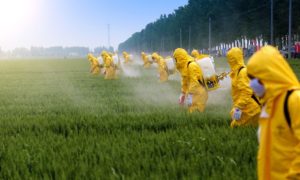Why are IQ scores declining over the previous 20 years?
by
Dr. Robert Gorter, Dr. Joseph Mercola, et al.
Robert Gorter, MD, PhD, emeritus professor of the University of California San Francisco Medical School (UCSF)
July 1st, 2018
Introduction to Why decline IQ scores?
Population intelligence quotients increased throughout the 20th century—a phenomenon known as the Flynn effect—although recent years have seen a slowdown and even a reversal of this trend in quite a few countries.
Interestingly, with the increase of the general use of fluoride in drinking water and the addition of Mercury and Aluminum in childhood vaccines from 1975 on, and the use of organic phosphor containing pesticides started taking place during the same period.
Mercury and Aluminum exhibit significant neurotoxicity and their detrimental effects in utero and in the maturing child have been documented by hundreds of independent researchers.

A question mark hangs over the long-term effects of many pesticides on consumers
Organophosphates (also known as phosphate esters) are a class of organophosphorus compounds with the general structure O=P(OR)3. They can be considered as esters of phosphoric acid. Like most functional groups, organophosphates occur in a diverse range of forms, with important examples including key biomolecules such as DNA, RNA and ATP, as well as many insecticides, herbicides, and nerve agents.
In this article, Dr. Robert Gorter pays attention to the devastating effects of pesticides on IQ scores and the brain development in the unborn and the maturing child.

General chemical structure of the organophosphate functional group. Notice that this group of Phosphor molecules plays an essential role in almost any metabolic process and DNA structures

Glyphosate (N-(phosphonomethyl)glycine) is a broad-spectrum systemic herbicide and crop desiccant. It is an organophosphorus compound, specifically a phosphonate. It is used to kill weeds, especially annual broadleaf weeds and grasses that compete with crops. It was discovered to be an herbicide by Monsanto chemist John E. Franz in 1970. Monsanto brought it to market for agricultural use in 1974 under the trade name Roundup, and Monsanto’s last commercially relevant United States patent expired in 2000.
Intelligence quotient (IQ) scores, which had been rising for decades throughout the 20th century, are now on the decline, and researchers with the Ragnar Frisch Center for Economic Research in Norway set out to determine why. The increasing trend, a phenomenon known as the Flynn effect, peaked in the 1970s and has been falling since. In fact, when the Norwegian researchers analyzed IQ scores from 730,000 men born between 1962 and 1975, IQ scores rose by about 3 percentage points a decade.(1)
Then, beginning with those born after 1975, they started to decline. IQ scores have often been tied to genetic factors, and it was long believed that people with higher IQs would have children with higher IQs and also that people with lower IQs would have more children (known as the dysgenic fertility theory), leading to an eventual lowering of IQ scores across the population.
The other important fact to know is that since 1975, mercury and aluminum have being added at a very large scale to vaccines against childhood diseases.
But the Norwegian study challenges both of these assumptions (genetic factors and dysgenic fertility), suggesting instead that declining IQ scores have little to do with genetics and everything to do with the environment.
Environmental Factors are Leading to Lower IQ Scores
What made the Norwegian study particularly interesting wasn’t only the reveal that IQ scores are on the decline. Because the researchers analyzed IQ scores of brothers, they were able to spot differences in IQ scores among families. Surprisingly, brothers born to the same parents often had significantly different IQ scores, suggesting an environmental factor — not a genetic one — was causing the disparity.
Also revealing, parents with higher IQs tended to have more children than people with lower IQs, challenging the dysgenic fertility theory. Study author Ole Rogeberg said in a news release,
“The causes in IQ increases over time and now the decline is due to environmental factors … It’s not that dumb people are having more kids than smart people, to put it crudely. It’s something to do with the environment, because we’re seeing the same differences within families.”2

As for what environmental factors are drawing down IQ scores, this remains to be seen, but access to education likely plays a role, with more education equating to higher IQ scores. Other environmental factors were also mentioned, including changes in nutrition and time spent on the internet or reading.
However, a number of environmental toxins that children are exposed to regularly have also been linked to cognitive effects, including lowered IQ. It could be that these toxic exposures are harming kids’ intelligence — and have been doing so for decades.
Fluoride Exposure Linked to Lower IQ
The featured study didn’t look in-depth into the environmental exposures that could be affecting IQ but other studies have. In the U.S., two-thirds of Americans’ tap water contains fluoride, which is added under the guise of preventing cavities. Water fluoridation continues to occur in the majority of the U.S. even as research stacks up that fluoride is a neurotoxin that can harm brain function. Fluoride also leaches lead out of old pipes, which further magnifies its neurological risks.
A study of Mexican women and children, published in 2017, found that higher exposure to fluoride while in utero is associated with lower scores on tests of cognitive function in childhood, both at the age of 4 and 6 to 12 years.(3)
While the children’s fluoride levels at ages 4 and 6 to 12 were not associated with their intelligence, the study found that exposure that occurs prenatally was linked to lower intelligence scores. In fact, women with higher levels of fluoride in their urine during pregnancy were more likely to have children with lower intelligence.
Specifically, each 0.5 milligram per liter increase in pregnant women’s fluoride levels was associated with a reduction of 3.15 and 2.5 points on the children’s General Cognitive Index (GCI) and Wechsler Abbreviated Scale of Intelligence (WASI) scores, respectively. In 2012, Harvard researchers also revealed that children living in high-fluoride areas had significantly lower IQ scores than those who lived in low-fluoride areas (4) and suggested high fluoride exposure may have an adverse effect on children’s neurodevelopment.
Then, in 2014, a review in Lancet Neurology classified fluoride as one of only 11 chemicals “known to cause developmental neurotoxicity in human beings,”5 alongside other known neurotoxins such as lead, methylmercury, arsenic and toluene. Among the proposed mechanisms of harm, studies have shown fluoride can: (6)
-
- Interfere with basic functions of nerve cells in the brain Reduce nicotinic acetylcholine receptors Reduce lipid content in the brain
- Damage the pineal gland through fluoride accumulation
- Impair antioxidant defense systems
- Damage the hippocampus
- Damage Purkinje cells
- Increase uptake of aluminum, which has neurotoxic effects.
- Encourage formation of beta-amyloid plaques (the classic brain abnormality in Alzheimer’s disease)
- Exacerbate lesions induced by iodine deficiency
Increase manganese absorption, which has also been linked lower IQ in children and impair thyroid function, which can also affect brain development
Flame Retardants Associated with Lower Intelligence in Children
Flame retardant chemicals known as polybrominated diphenyl ethers (PBDEs) are found in everything from furniture and mattresses to electronics and baby toys. Along with being linked to cancer, infertility, hormone disruptions and birth defects, they’re also contributors to neurodevelopmental delays and reduced IQ scores in children. One systematic review and meta-analysis looked into exposures to PBDEs that occurred near conception or during in utero, perinatal or childhood time periods.
Greater exposures to flame retardants during pregnancy were associated with lower intelligence in the child. Specifically, for every tenfold increase in prenatal exposure to PBDEs, there was a 3.7-point decline in IQ test scores in children.(7)
Past research has also demonstrated that children born to mothers with higher levels of flame retardant chemicals in their body had a 4.5-point average decrease in IQ,8 while exposure in childhood is strongly associated with poor attention span, reduced fine motor coordination and a decrease in cognitive ability.(9)
While a few-point reduction in IQ may seem small, the widespread exposure to flame retardants makes the decrease especially serious. Study co-author Tracey Woodruff told Medicine Net, “Even the loss of a few IQ points on a population-wide level means more children who need early interventions, and families who may face personal and economic burdens for the rest of their lives.”(10)
One way that exposure to flame retardants during pregnancy may harm children’s IQ could be via their influence on thyroid hormones. PBDEs are known to disrupt estrogenic activity as well as thyroid levels and, in one study, women with the highest concentrations of PBDEs in their blood had an increased risk of thyroid disease compared to those with lower concentrations.(11)
Meanwhile, research published in the New England Journal of Medicine (NEJM) revealed that children aged 7 to 9 who had mothers with untreated hypothyroidism in pregnancy had IQ scores about 7 points lower than youngsters of women without such a deficiency.(12)

Pesticide Exposure May Lower IQ
Exposure to organophosphate pesticides is another environmental factor linked to lower IQ. In a series of studies published in the journal Environmental Health Perspectives, women who had higher exposure to pesticides during pregnancy had children with lower IQ scores when they reached school age.(13)
.
In one of the studies, children with the highest pesticide exposures had a seven-point lower score on intelligence tests compared to children with the lowest exposures and, as The New York Times reported, “every tenfold increase in organophosphate exposure detected during pregnancy corresponded to a 5.5 point drop in overall I.Q. scores.”(14)
Further, according to estimates by David Bellinger, a professor in the department of environmental health at Harvard Medical School, Americans have lost a total of 16.9 million IQ points due to exposure to organophosphate pesticides. He also cites exposures to lead and methylmercury, via seafood consumption and childhood vaccinations, as other contributing factors to loss of IQ.
Glyphosate (N-(phosphonomethyl)glycine) is a broad-spectrum systemic herbicide and crop desiccant. It is an organophosphorus compound, specifically a phosphonate. It is used to kill weeds, especially annual broadleaf weeds and grasses that compete with crops. It was discovered to be an herbicide by Monsanto chemist John E. Franz in 1970. Monsanto brought it to market for agricultural use in 1974 under the trade name Roundup, and Monsanto’s last commercially relevant United States patent expired in 2000.
Farmers quickly adopted glyphosate, especially after Monsanto introduced glyphosate-resistant Roundup Ready crops, enabling farmers to kill weeds without killing their crops. In 2007, glyphosate was the most used herbicide in the United States’ agricultural sector and the second-most used in home and garden (2,4-D being the most used), government and industry, and commerce. By 2016 there was a 100-fold increase from the late 1970s in the frequency of application and volume of glyphosate-based herbicides (GBHs) applied, with further increases expected in the future, partly in response to the global emergence and spread of glyphosate-resistant weeds.
Glyphosate is absorbed through foliage, and minimally through roots and transported to growing points. It inhibits a plant enzyme involved in the synthesis of three aromatic amino acids: tyrosine, tryptophan, and phenylalanine. Therefore, it is effective only on actively growing plants and is not effective as a pre-emergence herbicide. An increasing number of crops have been genetically engineered to be tolerant of glyphosate (e.g. Roundup Ready soybean, the first Roundup Ready crop, also created by Monsanto) which allows farmers to use glyphosate as a post-emergence herbicide against weeds. The development of glyphosate resistance in weed species is emerging as a costly problem.
Children are Especially Vulnerable to Chemical Exposures
Part of what makes environmental chemical exposures so damaging is their widespread prevalence, and the fact that children are exposed to multiple chemicals both in utero and after birth. Bellinger wrote: (15)
“Based on the estimated number of FSIQ [full-scale IQ] points lost, the population burdens associated with environmental chemical exposures of children are surprisingly large — in some cases larger than those estimated for major medical conditions and events (i.e., preterm birth, traumatic brain injury, brain tumors, congenital heart disease).
This is attributable not so much to the magnitude of the effect sizes associated with chemicals, but to the prevalence of exposures associated with adverse impacts.”
Children are especially vulnerable, as they experience greater exposure to chemicals pound-for-pound than adults,(16) and though the blood-brain barrier is fully formed at birth, its function may be immature, which may allow greater chemical exposures to reach their developing brain.
Children also have lower levels of some chemical-binding proteins, according to the Environmental Working Group (EWG), which allows more of a chemical to reach their organs, while systems that detoxify and excrete chemicals in adults are not fully developed.
These factors, coupled with the fact that a child will be around for 80 years or more, allowing more than enough time for chemicals to do their damage, signals a major challenge for kids born today. Exposure that occurs in utero may be even more problematic, as EWG reported:
“The pace and complexity of growth and development in the womb are unmatched later in life. Three weeks after conception, an embryo, still only 1/100th the size of a water droplet, has nevertheless grown at such an explosive rate that were it not to slow down, it would be born literally the size of a million Earths.
“… At no other time in life does a person create so much from so little in so short a time. Industrial chemicals that interrupt this intricate process can, at high levels, wreak havoc in the form of severe birth defects, or at lower levels cause subtle but important changes in development that surface later in childhood as learning or behavioral problems, or in adulthood in the form of certain cancers or perhaps neurodegenerative disease.”
Top Tips for Protecting Intelligence
are many factors that contribute to a person’s intelligence, but from the standpoint of environmental ones, limiting exposure to the chemicals listed above makes sense. You can do this by:
Filtering Your Water to Remove Fluoride
Fluoride is a very small molecule, making it tremendously difficult to filter out once added to your water supply. Any simple countertop carbon filter, like Brita, will not remove it. Among the more effective filtering systems for fluoride removal are:
- Reverse osmosis (RO). The drawback is that it will remove many valuable minerals and trace elements as well. RO systems also need frequent cleaning to avoid bacterial growth. So, use a tankless RO system with a compressor. Water distillation, which, like RO, gets everything out, including beneficial minerals. You then need to restructure the water.
- Bone char filters and biochar.
Clearly, the simplest, most effective, most cost-effective strategy is to not put fluoride in the water to begin with. To learn more about fluoride and how you can help end this harmful practice, I highly recommend getting a copy of “The Case Against Fluoride: How Hazardous Waste Ended Up in Our Drinking Water and the Bad Science and Powerful Politics That Keep It There“, a book by Paul Connett, Ph.D., toxicologist, environmental chemist and former director of the Fluoride Action Network (FAN). You can also download a free report on water fluoridation.
Avoiding Flame Retardant Chemicals
These chemicals are widespread in consumer products, but there are steps you can take to reduce your exposure, including these tips from the Green Science Policy Institute. (17)
Avoid upholstered furniture with a TB117 label. If the label states, “This article meets the flammability requirements of California Bureau of Home Furnishings Technical Bulletin 117 … ” it most likely contains flame retardants. However, even upholstered furniture that’s unlabeled may contain flame retardants.
Furniture products filled with cotton, wool or polyester tend to be safer than chemical-treated foam; some products also state that they are “flame-retardant free.” Organic wool (100 %) is naturally flame-resistant.
Avoid baby products with foam. Nursing pillows, high chairs, strollers and other products containing polyurethane foam most likely contain flame retardants.
Avoid foam carpet padding. If possible, minimize the use of foam carpet padding, which often contains flame retardants. If removing carpeting, take precautions to avoid exposures. You’ll want to isolate your work area from the rest of your house to avoid spreading it around, and use a HEPA filter vacuum to clean up.
PBDEs are often found in household dust, so clean up with a HEPA-filter vacuum and/or a wet mop often. Washing your hands regularly can also help.
Minimizing Exposure to Pesticides
Research shows that eating organic leads to lower levels of pesticides in your body. In one study, when a family of five switched to an all-organic diet for two weeks, their body levels of pesticides dropped significantly, decreasing by a factor of 6.7.18 If you must choose between which products to purchase organic, I personally recommend prioritizing organic animal foods first and then using EWG’s Dirty Dozen list for produce.
For the nonorganic produce you consume, washing with a solution of baking soda may help to remove some of the pesticides on the surface of the fruit or vegetable,(19) although it won’t remove chemical residues that have penetrated beyond the peel. Peeling is another option to reduce pesticide residue, but this also means you’re removing the healthy compounds contained in the peel (and there can still be residues that have penetrated into the produce flesh).
For these reasons, the best way to avoid pesticide residues in your food is to choose those that haven’t been exposed to them to begin with, i.e., go organic. In addition, avoid spraying pesticides around your home; opt for natural solutions to pest control instead.
Optimizing Your Diet is Crucial for a Healthy Brain
Nutrition also plays a role in intelligence, and this includes during pregnancy. Omega-3 fats are incredibly important and have been linked to cognitive benefits for children both during pregnancy and in early life.(20) When boys were given an omega-3 supplement, there were significant increases in the activation of the dorsolateral prefrontal cortex part of the brain.(21)
This is an area of your brain associated with working memory. They also noticed changes in other parts of the brain, including the occipital cortex (the visual processing center) and the cerebellar cortex (which plays a role in motor control). Small cold-water fish that are rich in animal-based omega-3 fats but have a low risk of contamination are among your best choices for healthy omega-3s. This includes anchovies, sardines, mackerel, herring and wild-caught Alaskan salmon. Krill oil is a supplement alternative.
Other important nutrients include choline, found in cruciferous veggies, leafy greens and pastured organic egg yolks. Choline intake during pregnancy “super-charged” the brain activity of animals in utero, indicating that it may boost cognitive function, improve learning and memory and even diminish age-related memory decline and the brain’s vulnerability to toxins during childhood, as well as conferring protection later in life.(22)
In addition, people with higher choline intakes were shown to have better cognitive performance, doing better on tests of verbal and visual memory, than those with low intake.(23) Ultimately, protecting the intelligence of future generations will depend on removing known neurotoxins from the environment, but you can also make a difference individually by avoiding chemical exposures, eating right and leading a healthy lifestyle overall.
Dr. Robert Gorter:
“Recent studies in both animals and humans document clearly that cannabidiol (CBD) can improve cognitive functions and delay or reverse aging of the brain and dementia (including Alzheimers).”

Born and raised in the inner city of Chicago, IL, Dr. Joseph Mercola is an osteopathic physician trained in both traditional and natural medicine. Board-certified in family medicine, Dr. Mercola served as the chairman of the family medicine department at St. Alexius Medical Center for five years, and in 2012 was granted fellowship status by the American College of Nutrition (ACN).

Prof Jim Flynn at the 40th Anniversary of the Political Studies Department at the University of Otago (June 8, 200)
The Flynn effect is the substantial and long-sustained increase in both fluid and crystallized intelligence test scores measured in many parts of the world over the 20th century. When intelligence quotient (IQ) tests are initially standardized using a sample of test-takers, by convention the average of the test results is set to 100 and their standard deviation is set to 15 or 16 IQ points. When IQ tests are revised, they are again standardized using a new sample of test-takers, usually born more recently than the first. Again, the average result is set to 100. However, when the new test subjects take the older tests, in almost every case their average scores are significantly above 100.
Test score increases have been continuous and approximately linear from the earliest years of testing to the present. For the Raven’s Progressive Matrices test, a study published in the year 2009 found that British children’s average scores rose by 14 IQ points from 1942 to 2008. Similar gains have been observed in many other countries in which IQ testing has long been widely used, including other Western European countries, Japan, and South Korea.
Similar improvements have been reported for other cognitions such as semantic and episodic memory. Research published in 2018 suggests that the Flynn effect may have ended in at least a few developed nations, including Norway.
If the Flynn effect has ended in developed nations, then this may possibly allow national differences in IQ scores to diminish if the Flynn effect continues in nations with lower average national IQs.
Also, if the Flynn effect has ended for the majority in developed nations, it may still continue for minorities, especially for groups like immigrants where many may have received poor nutrition during early childhood or have had other disadvantages. A study in the Netherlands found that children of non-Western immigrants had improvements for g, educational achievements, and work proficiency compared to their parents, although there were still remaining differences compared to ethnic Dutch.
Sources and References:
1 PNAS June 11, 2018. 201718793
2 CNN June 13, 2018
3 Environmental Health Perspectives September 2017, Volume 125, Issue 9
4 Environmental Health Perspectives October 2012, Volume 120, Issue 10
5 Lancet Neurology 13(3):330-38
6 Fluoride Action Network, Effects of Fluoride on Brain
7 Newsweek August 4, 2017
8 Environmental Health Perspectives August 2014; 122(8)
9 Environmental Health Perspectives, 2013 Feb;121(2):257-62
10 Medicine Net August 4, 2017
11 Environmental Health May 24, 2016
12 N Engl J Med 1999; 341:549-555
13 Environ Health Perspect 119:1189-1195 (2011).
14 The New York Times April 21, 2011
15 Environ Health Perspect; DOI:10.1289/ehp.1104170
16 Nature Biotechnology 27, 804 – 805 (2009)
17 Green Science Policy Institute, Flame Retardants
18 Coop The Organic Effect
19 J. Agric. Food Chem. October 25, 2017
20 The American Journal of Clinical Nutrition June 26, 2013
21 American Journal of Clinical Nutrition April 2010;91(4):1060-7
22 J Neurophysiol. 2004 Apr;91(4):1545-55.
23 The American Journal of Clinical Nutrition, Volume 94, Issue 6, 1 December 2011, Pages 1584–1591
Also recommended reading:
https://www.ncbi.nlm.nih.gov/pmc/articles/PMC4152423/
| @U.S. National Library of Medicine – Bethesda MD |
Cancer, DNA Damage, Cellphones and 5G — What You Need to Know
Anxiety Overtakes Depression as No. 1 Mental Health Problem
How LED Lighting May Compromise Your Health
Magic Mushrooms May Hold Key to Long-Term Relief from Anxiety and Depression
Medical Errors: Still the Third Leading Cause of Death
Photobiology: How Therapeutic Use of Full-Spectrum Light Can Improve Your Health
Scientific Links Between Processed Foods and Depression
How Sugar Harms Your Brain Health and Drives Alzheimer’s Epidemic
Is Most Back Pain Caused by Repressed Emotions?
Confirmed: Artificial Sweeteners Make You Fat and Sick


 Deutsch
Deutsch Nederlands
Nederlands Turkish
Turkish Russian
Russian Italiano
Italiano Français
Français Português
Português العربية
العربية